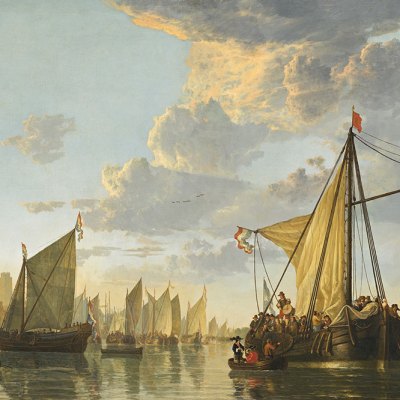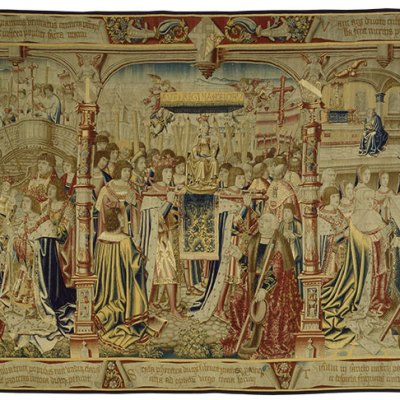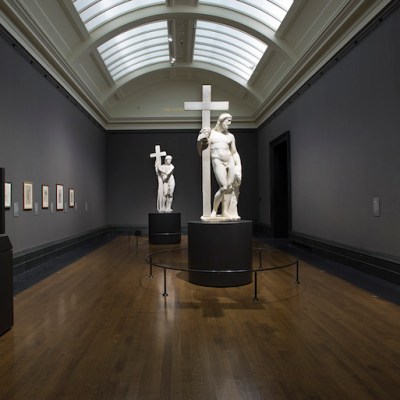Imagine walking into the Sistine Chapel and not looking up. It seems inconceivable that the eye could fail to be drawn heavenward to Michelangelo’s epic ceiling frescoes representing scenes from the Book of Genesis and those eloquent, near-touching fingers of God giving life to Man in The Creation of Adam. Yet that was the effect of the Vatican Museums returning to their original setting the Acts of the Apostles tapestries that were woven to designs commissioned from Raphael in late 1514 or 1515 – the full-scale ‘Raphael cartoons’ in the Victoria & Albert Museum in London. This breathtaking – although not uncontentious – display lasting just one week (February 17–23) was intended a special tribute to mark the 500th anniversary of Raphael’s death in Rome in 1520. It was the first time that all of the 10 known tapestries completed by 1521 have hung together in the Sistine Chapel since the 16th century.
The tapestries were Pope Leo X’s greatest contribution to the Sistine, the ‘Cappella Magna’ of the Vatican Palace and the setting for the principal liturgical ceremonies of the papal court. They were intended to be hung on great occasions over the section of wall frescoed with trompe l’œil hangings beneath the frieze of narrative scenes from the life of Moses and the life of Christ, produced by a team of painters including Botticelli, Perugino, Pinturicchio and Ghirlandaio, and completed in 1482. Their subjects, appropriately enough, were the lives of St Peter and St Paul, the two apostles represented as the founders of the Christian Church in Rome and the sources of the Pope’s authority.
There is little doubt that they were intended to rival the magnificence of Michelangelo’s great ceiling and they did so not only courtesy of Raphael’s genius, but also by virtue of the fact that they literally dazzled spectators. Extraordinary quantities of silver and gold thread, as well as coloured wool and silks, were employed by the weavers in the workshop of Pieter van Aelst in Brussels. Their cost was, according to one account, five times the amount Michelangelo received for the ceiling. Painting was then the (relatively) poor man’s mosaic or tapestry.
Tapestries illustrating the life of Peter, designed by Raphael, hanging in the Sistine Chapel, Rome, 2020. Photo: © Governatorato SCV – Direzione dei Musei

What we witnessed last week was not the experience of 16th-century viewers. For one, the chapel has changed greatly. In the 1530s Michelangelo was commissioned to paint the Last Judgment on the altar wall, usurping space previously filled by some of the quattrocento frescoes and tapestries; in the 1550s the screen in the chapel separating the space for the clergy and the space for the laity was moved. We have absolutely no idea where or in what sequence the tapestries were originally displayed in the chapel, nor are we even certain how many of them were commissioned or made – Antonio de Beatis, who visited Pieter van Aelst’s workshop in 1517, reports in his diary that 16 tapestries were being woven for Leo X for 2,000 ducats apiece. What we do know is that scholars have argued the finer points over several decades, and will continue to do so.
The proposition argued by this display, rather than earlier partial rehangings of the tapestries, is that the series relating to Peter hung on the left (or south) wall under the 15th-century fresco cycle illustrating the life of Moses, and not on the right (or north) as was previously generally agreed. (The argument is elucidated in a forthcoming Vatican publication.) Of course, each of the two series may never have been restricted to a single wall, and may have been organised according to aesthetic as well as architectural considerations. Whatever the case, the tapestries do not make sense in any order in the chapel as it is now arranged. The tapestries are framed by decorative pilasters which are either woven separately or together with the narrative scenes and their lower monochrome borders. It seems inconceivable that these would not have aligned (and they currently cannot) with the painted pilasters that separate the fresco scenes above.
The other significant change is that some of the tapestries are but glimmering shadows of their former selves. They have weathered a lot. It seems likely that most if not all of the narrative scenes and borders were stolen during the Sack of Rome in 1527, some even seized by pirates, and others probably melted down for their metal content. John Shearman has argued that all but the Conversion of Saul and Paul Preaching at Athens had been returned by the 1530s, and The Conversion of the Proconsul recovered as a fragment. Any missing panels were replaced from later weavings of the set. Over the centuries these most precious of tapestries have been hung in cloisters or even on exterior walls.
Tapestry of the Miraculous Draught of Fishes, designed by Raphael for the Sistine Chapel. Photo: © Governatorato SCV – Direzione dei Musei

Where the mastery of both artist and weaver is most brilliantly illuminated is in the Miraculous Draught of Fishes, also the most compelling and imaginative of the cartoons – all of which were worked up to a level of detail and subtlety of colour far beyond the usual instructions given to weavers. Here Christ tells Peter, the ‘fisher of men’, to cast his net into the waters, whereupon he and his fellow apostles make a miraculous catch. Framed by symbolically ‘vigilant’ cranes in the foreground, this airy, watery scene is a tour de force of shimmering reflections. It is little wonder that Vasari marvelled (of the whole set): ‘It is truly rather a miracle than the work of human art, seeing that in these tapestries are animals, water, and buildings, all made in such a way that they seem not to be woven, but really wrought with the brush.’
It would be fascinating to know what the Flemish weavers made of it all. After all, they were used to depicting tapestries featuring repeating decorative patterns rather than realising monumental, volumetric figures in complex illusionistic settings. In Paul Preaching at Athens, their struggle with architectural perspective, curving line, and the foreshortening of figures is particularly evident. Quite a lot is, as it were, lost in translation.
The real revelation of the display, for this spectator at least, was the tapestries’ transformative effect on the whole chapel. Not only did they lower the eye but they unexpectedly also refocused attention on the quattrocento frescoes above them, works usually so overshadowed by Michelangelo’s ceiling and Last Judgment that they are somewhat ignored. Raphael’s designs have far more in common with these earlier narrative scenes than they do with the almost contemporaneous frescoes by Michelangelo, which suddenly seem oddly anomalous. The more visually coherent narrative frescoes and tapestries also emphasise the disconcerting differences in scale of the ceiling figures, the result of Michelangelo removing his scaffolding halfway through the commission and realising that he had to simplify his compositions and work on a far larger scale. It is tempting to believe, given the intense rivalry between these two great titans of the Italian renaissance, that Raphael was not unaware of this outcome.


